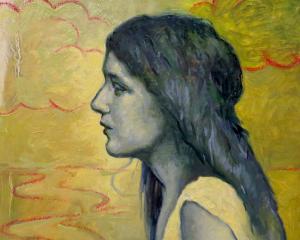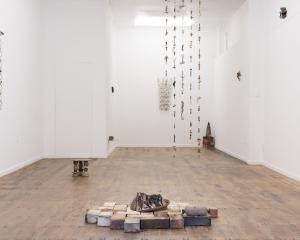
(Brett McDowell Gallery)
Direct from the Dowse Art Museum, a new iteration of Suji Park’s "Noise Collector" has been activated by the daylight at Brett McDowell Gallery. Predominantly ceramic vessel forms comprise a recent body of work from a residency at the Factory of Contemporary Arts in Palbok, Jeonju in Korea, where Park is now based. The works sit atop the travel cases they arrived in, gathered and animated as a small sparkly chorus.
Park articulates a practice of making that correlates with music, and ways of being and connection with world. Sound, colour and the physical experience of language and communication are considered in the open vessel and the circular form. The titles of the "Feverheads" series all begin with the letter O (Oaah, Oori, Oya ... ). They mirror the e-eung letter in the Korean language as a reference to the mouth, demonstrating one of the ways Park makes embodied connections between her ideas.
Part of Park’s process involves breaking and remaking pieces, and we can see evidence of this in reformed cracks and small reinforcements. Some, like "Beatdol ii", are conglomerate works with plastic, plaster, foam, resin and paint added over time. Ribbons of beads connect to the ceilings and cutout shapes and reflective panels create shimmering, alive surfaces that both form and interact with this collection.

(Dunedin Public Art Gallery)
With over 80 guest contributing artists, Peter Robinson (Kāi Tahu) has installed an exhibition that fills the gallery space completely. In "Kā Kaihōpara" (The Explorers), the audience circumnavigates a central landscape of many sculptural pieces, alongside floor-to-ceiling works on paper.
The exhibition is an outcome of recent research across personal and collective modes of making. For the artist, the idea of exploration sits as a governing approach to navigating the unknown — topics range across histories of art making and contemporary realities. Robinson has asked friends and whānau to join him in ongoing conversation.
The largest pieces in this cohesive, elegantly untidy installation are formed from depleted building supply stock. Long vessel-like, extended and bent-into-shape wood-grained cuts of aluminium, lie lengthwise down the room. Plastic deckchair shards, buckets and crates, wigs, hats and shoes, and stacked arrangements of smaller motifs in metal are placed evenly among other bits and taller framework figures.
The hundreds of drawings that line the walls can be categorised and linked, both compositionally across the space and within the relational contexts of the people involved. Among many things, they are daily drawing practices from the artist’s studio, or students’, friends’ and colleagues’ works. They are conceptual statements and referents to process. When the viewer walks through the space they are also drawn into the exploration.

(Milford Galleries Dunedin)
Contextualised within Bridget Reweti’s (Ngāti Ranginui, Ngāi Te Rangi) wider practice is a showcase of tintypes, a low-light direct positive photographic technique (invented in the 1850s). The subject matter of this series is the flora endemic to surrounding areas of Wai Ōtākau/Otago Harbour.
The photographs are small, warm-toned with a lustrous silver sheen and a rich depth to the darker tones and shadows. Due to their size, they are best viewed closely. The detail of each plate is subtle and finely rendered by the light. While technically and chemically made by sunlight processes, they have moonlit or night-spotlight atmospheric qualities — a distinct yet obscured clarity.
The documentary of place becomes mysteriously and astutely localised and historicised through the tintype. Reweti has looked to distinctive features of a number of different species — from kahikatea and tōtara, to the smaller makomako and waihirere — highlighting the identifying characteristics of different foliage. Within Reweti’s continued engagement with indigenous landscape perspectives and narratives through the lens of early photographic techniques, the viewer is drawn to consider, imagine and think through landscapes of time past. Small sculptural and glassy photograms on rough-edged seawall stones complete the series with direct links to place.
By Joanna Osborne








![Rozana Lee, "Drawn to see(a)" [Installation view]. Photo: Beth Garey](https://www.odt.co.nz/sites/default/files/styles/odt_landscape_small_related_stories/public/story/2024/10/blue_oyster_r_lee.jpg?itok=IGhlKMSl)



![Phaeacia (2024), by Paul McLachlan [detail]. Acrylic and rust on canvas.](https://www.odt.co.nz/sites/default/files/styles/odt_landscape_small_related_stories/public/story/2024/09/paul_mclachlan_phaeacia_de.jpg?itok=UuQsvnQc)